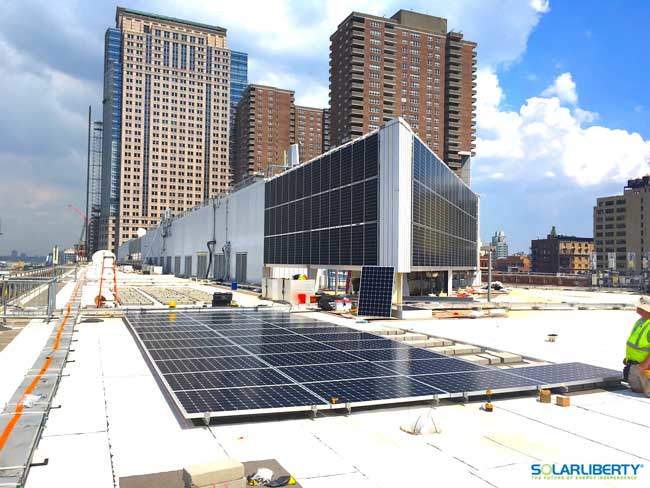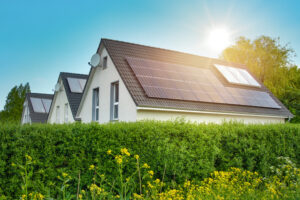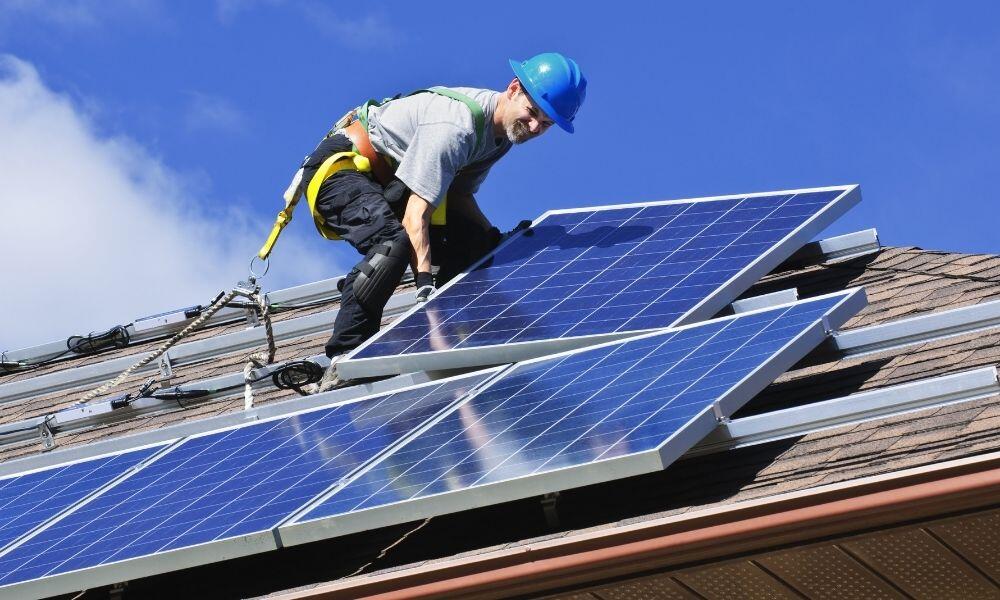BMCC Rooftop Now Home to Manhattan’s Largest Solar Panel Project

Workers from the New York Power Authority (NYPA) have installed 947 solar energy panels on the main roof of Borough of Manhattan Community College’s (BMCC/CUNY) four-block-long 199 Chambers Street building. The five by three foot panels of 327 watts—many of which are visible from the streets of Tribeca—are hung vertically on the cooling tower enclosure walls and flat on the western lower roof facing the Hudson River for maximum exposure to the sun.
The BMCC solar array is now the largest public photovoltaic facility on Manhattan island, and has the added distinction of being the first vertical solar facility in all of New York City according to NYPA. First proposed in 2008, the project’s design has improved as technology changed and after BMCC removed its old roof, installed four inches of R-25 insulation and recapped the four-block-long roof.
Each of the solar panels contain 96 cells that will absorb the sun’s rays then feed them into an inverter that converts the light into electricity. The electricity produced powers the Chambers Street building first with any excess generated distributed into the New York City power grid.
BMCC is working collaboratively with regulators including the New York City Department of Buildings and The New York City Fire Department for permits to store solar power in two large 100-killowatt hour (kWh) batteries. These backup batteries would serve as energy reserves during peak load periods—after a series of hot summer days—to alleviate some of the strain on the city’s electrical resources. In addition, the electrical reserves can provide power for critical functions, such as emergency lighting, refrigeration for scientific experiments and IT systems, power for the college’s electric vehicle and generators, in the event of a blackout or other emergency situation.
Working toward a more sustainable future
The project, a collaborative effort between the New York Power Authority’s Energy Services Program and BMCC/CUNY, is part of a greater effort to reduce CUNY’s utility costs, improve energy efficiency and reduce its carbon footprint. The project is also contributing to New York Governor Andrew M. Cuomo’s efforts to increase solar power in New York State and create a shift towards a more sustainable, resilient and cost-effective energy future.
“Borough of Manhattan Community College has really stepped up to the plate when it comes to investing in alternative energy resources and advancing clean energy technologies,” said Gil C. Quiniones, NYPA President and CEO. “NYPA is pleased to have led the implementation of this latest major energy-saving project, which will help New York State continue to be a leader in energy efficiency and meet Governor Cuomo’s ambitious goal to supply 50 percent of its electricity from renewable sources by 2030.”
Capable of producing over 1MWH (1000kWh) of electricity each day, the BMCC solar array is expected to save the college more than $42,000 each year on its power bill. The reduction in annual greenhouse emissions equates to more than 25,000 gallons of gas, which equates to 48 passenger vehicles being taken off the road or total power use for 24 homes.
“We’re are leading the charge to utilize cleaner and greener energy that also saves on costs,” said G. Scott Anderson, Vice President, Administration and Planning, BMCC who says the college’s overall mission is to be more sustainable and green. “What we’ve done at BMCC is use the pre-existing resources we’ve been given – in this case using our extremely long roof—to help us be more energy efficient. Our partnership with NYPA simplified the process and helped ensure that we met our strategic energy and environmental goals.”
The concentration of buildings in New York City is so dense that local leaders have come to embrace more aggressive policies that center on saving energy, Anderson says.
BMCC at the forefront of energy conservation
Buildings account for 39 percent of primary energy consumption and 72 percent of all electricity consumed in the United States, according to the U.S. Department of Energy’s buildings energy data book. Buildings account for more energy use than the entire U.S. transportation sector and they produce more greenhouse gas than any other country in the world except China.
In the past four years, “BMCC has been in the forefront of energy conservation and sustainability from insulating and greening its roofs, putting LED lights and motion sensors in its classrooms and public spaces, installing hydration stations in the hallways, and using thermal blankets and steam traps around its pipes,” according to Thomas Ching, Chief Administrative Superintendent. Since 2012, BMCC has been able to reduce its energy use by 19.6 percent based on NYC Department of Citywide Administrative Services data. DCAS oversees BMCC’s energy use and payments. “Even with increasing enrollment and the attendant energy demands, BMCC continues to find new ways to conserve energy with the solar panels being the latest energy-efficient practice in our sustainability repertory,” says Ching.
Project design and construction were led by The Fulcrum Group, which contracted with Solar Liberty and Maric Mechanical to complete the PV system installation.




